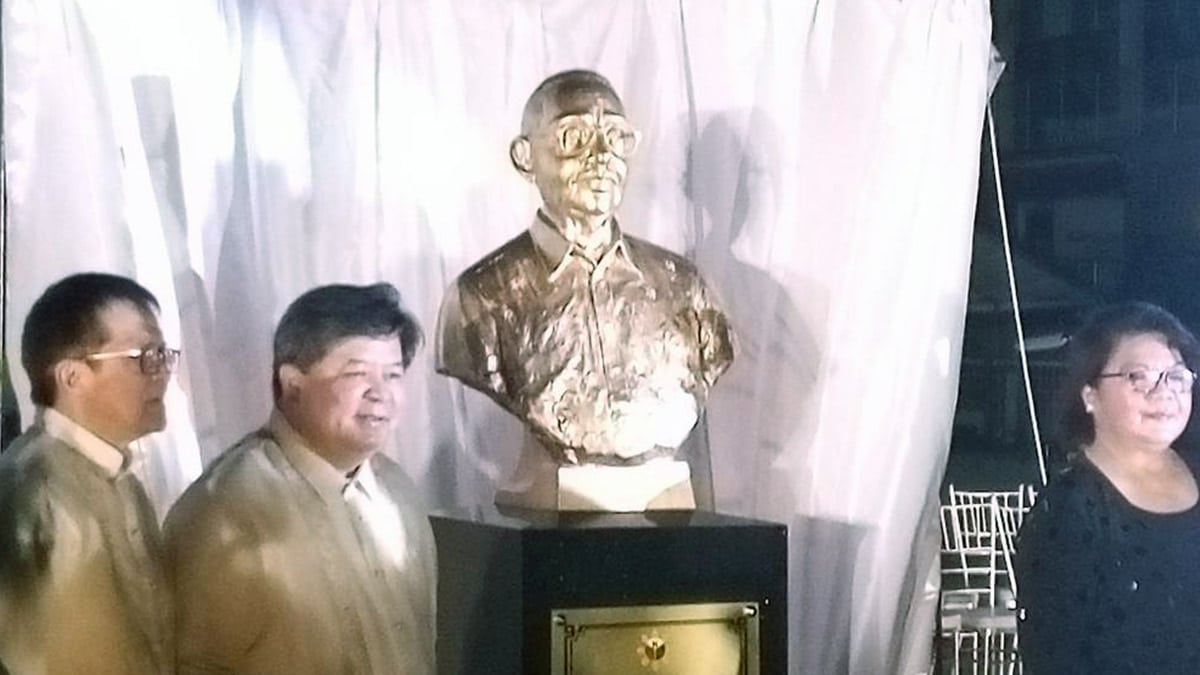
Bust of Romero by sculptor Frederic Caedo unveiled in Dumaguete, with (from left) his son, director Joey Romero, Mayor Felipe Antonio Remollo and NCCA’s Marichu Tellano —PHOTO BY AMADIS MA. GUERRERO
From childhood onwards, Edgar Sinco Romero—later known simply as Eddie Romero—was drawn to literature and movies. He started writing stories when he was 7 and, by the time he was 16, one of his stories, “Oh Johnny Oh,” was published in the prestigious Philippines Free Press. His career as a film director began in the late 1940s and spanned six decades.
Romero wrote his screenplays in English, later translated into Tagalog. He often produced or coproduced his films. He wrote the script for “Ang Maestra” (1941), one of the early successes of Gerry de Leon, who became his mentor.
Another major influence was Japanese director Yasujiro Ozu.
“Ang Maestra” starred Rogelio de la Rosa and Sylvia la Torre, one of the many leading actors and actresses who would be directed by the future national artist from Dumaguete City, Negros Oriental.
Romero’s first movie was “Ang Kamay ng Diyos” in 1947, followed two years later by “Diego Silang,” for which he won a best director award. His 1953 production, “Ang Asawa Kong Americana,” was the first film to win an important award in an Asian film festival.
As a child, I remember seeing Romero’s “The Day of the Trumpet” (1957), his first movie to be released internationally, a highly romanticized, almost laughable version of the Philippine-American War. In one scene, a Filipina extra exclaimed to Alicia Vergel, “Nandito na ang mga Amerikanong sundalo … ang ga-guapo nila!” (Here come the American soldiers, so handsome).
Then, there was the famous kiss between Vergel and leading man John Agar, and after the take, she was reported to have scampered away, crying. Agar laughed, “This was the first time I kissed a leading lady and she went away bawling!”
“The Passionate Strangers” (1966) was a film noir about labor unrest and a murder in Negros Occidental, shot in Dumaguete and nearby towns. By the late 1970s and early ’80s, Romero’s career reached its peak. Many of his movies were commercial in nature, but much of his reputation rests on his towering masterpieces, “Ganito Kami Noon, Paano Kayo Ngayon?” (1976) and “Aguila” (1980).
The director-writer-producer was given many awards, foremost of which was the Order of National Artist (for film and broadcast arts) in 2003. He died in 2013 at the age of 87.
Birth anniversary
A recent three-day celebration in Dumaguete, organized by the National Commission for Culture and the Arts (NCCA) and partner agencies, honored the birth centennial of Romero with lectures and screenings of his restored films.
At the Luce Auditorium of Silliman University, Romero’s alma mater, film historian Nick Deocampo discussed the life and works of the national artist, while Rosemarie Roque of the Society of Filipino Archivists described digital archiving (Romero was a film archivist in the 1980s) as “one of the memory institutes.” Leo Katigbak of ABS-CBN Archives and Jeffrey Sonora of FPJ Archives also discussed film restoration.
“Restoring a film may seem very simple, but it is actually very complicated,” explained Sonora. A slide presentation showed the painstaking process involved in restoring a film, in this case “Aguila,” starring Fernando Poe Jr. The video showed a fascinating series of scenes from the movie described as “original” then compared to “restored,” demonstrating the difference.
Two of his films were shown at the Luce Auditorium: the restored “Ganito Kami Noon, Paano Kayo Ngayon?” and “Kamakalawa” (1981).
“Ganito Kami…” was cowritten by Roy Iglesias and one of the production designers was Peque Gallaga, with music by Lutgardo Labad. The story was that of naive peasant boy Kulas (Christopher de Leon) who stumbles through the Philippine revolution and the Philippine-American war, and finally discovers his identity as a Filipino.
Deocampo, who spoke about the film, later shared with the media his study guide for students.
A typical question would be: What is the film about? What does it contain in its story and visual content that makes it a significant historical and cultural document for Filipinos?
“Kamakalawa” was about pre-Spanish indigenous groups in the throes of conflict, with touches of magic and fantasy. It showed the young Boyet de Leon in “bahaghari,” in all his manly beauty, the cynosure of all eyes from the women and gays in the audience.
There were many funny lines in the movie, though not all from the comedian Apeng Daldal; and I concluded that it was a fun movie, not to be taken seriously.
The eagle as symbol
In stark contrast was “Aguila,” which was presented at Pantawan People’s Park on Rizal Boulevard, restored in all its former glory, with a clear sound. We see the young Daniel Aguila as a little boy embroiled in the Philippine revolution against Spain, with his mother played by Amalia Fuentes—still beautiful amidst the chaos of war. The traitor (played by Eddie Garcia) attempts to rape her and her screams resound through the forest.
Next, we see the now grown-up Daniel (Ronnie Poe) as an officer in the American-ruled Constabulary. It is 1917 in Cotabato. Daniel is being eyed by a pretty dancing Muslim girl (Sandy Andolong).
And thus the three-and-a-half-hour epic sweeps through 80 years of Philippine history. At the end, we see Daniel as an old man as the eagle streaking through the sky reappears, a symbol of the Filipino’s search for freedom.
The three-day centennial celebration was capped by the unveiling of the bust of Romero created by sculptor Frederic Caedo. The unveiling was done by Mayor Felipe Antonio Remollo; the national artist’s son, Joey Romero, himself a director; and NCCA Deputy Executive Director Marichu Tellano, who observed that the works of Romero “are timeless and we learn new lessons from watching his films.” INQ